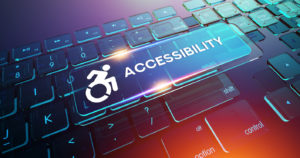 In today’s landscape of workforce shortages and a focus on diversity, equity and inclusion, individuals with disabilities represent a vast pool of untapped talent. Employers who actively hire people with disabilities often witness numerous benefits, including increased productivity, higher profit margins, improved morale, better attendance and lower turnover rates. However, finding this talent can be a challenge for many organizations.
In today’s landscape of workforce shortages and a focus on diversity, equity and inclusion, individuals with disabilities represent a vast pool of untapped talent. Employers who actively hire people with disabilities often witness numerous benefits, including increased productivity, higher profit margins, improved morale, better attendance and lower turnover rates. However, finding this talent can be a challenge for many organizations.
One efficient way to connect with potential employees with disabilities is through a job fair specifically designed for them. Unfortunately, some employers are hesitant to organize such an event due to unfamiliarity with its intricacies. Employers often fear that accommodations for employees with disabilities will be too costly — a myth that has been debunked for years.
Don’t Fear Accommodations
Research conducted by the US Department of Labor and the Job Accommodation Network reveals that nearly half of the workplace accommodations cost nothing, and the remaining accommodations incur a one-time cost of only $300. Moreover, these accommodation costs for a job fair, typically a day-long event, are even lower.
At PRIDE Industries, we know from experience that the value that people with disabilities bring to the workforce — in terms of diversity, workplace culture and an overall better bottom line — is well worth the effort to be inclusive and accommodating.
We recently set out to create our first on-the-ground job fair for people with disabilities. Scheduled to take place October 18, coinciding with National Disability Employment Awareness Month (NDEAM), the I AM ABLE Disability Job Fair aims to bring together job seekers and employers in a supportive and inclusive environment, specifically for wheelchair users and people with blindness and low vision, autism, and deafness and hearing loss.
PREMIUM CONTENT: Global Talent Platform Survey 2023
Here are some best practices for an inclusive job fair or any event.
Wheelchair access. For wheelchair accessibility ensure ramps are clear of any debris, as even small objects can pose a significant risk for wheelchair users.
Other issues to consider are table height for comfort of wheelchair-using job seekers during interviews and providing ample space for maneuverability, both in thoroughfares and between tables to accommodate individuals using wheelchairs as well as their service animals. It is also important to provide appropriate facilities for service animals’ needs.
Access for blind attendees. For people with blindness and low vision, it is important to provide adequate space to accommodate individuals using canes or service animals.
Braille signage on all tables — including numbering, along with braille maps highlighting the location of each organization’s table — will significantly improve accessibility. The Society for the Blind offers a Braille Production and Training Program that can help. The placement of reading materials should also be considered, as people with significant vision loss won’t know where the middle of the table is, for example. Place materials on designated corners of each table.
Access for deaf attendees and those with hearing loss. American Sign Language (ASL) translators should be positioned at the event’s registration area. You can find interpreters at the Registry for Interpreters for the Deaf.
These translators can also accompany deaf job seekers to various tables and on-site interviews, ensuring effective communication. Another recommendation is to put whiteboards at each table, allowing deaf attendees to write down their questions and receive written responses.
Access for attendees on the autism spectrum. For people with autism, it is very valuable to create quiet spaces for job seekers. These spaces can serve as interview areas or places for conversations with potential employers, providing a distraction-free environment.
It’s easier for some people with autism to write their questions and answers, rather than speaking and listening. The same whiteboards used for people with deafness and hearing loss can be used by people with autism. Interviewers should also understand that it may take longer for some people on the spectrum to respond to questions.
Think Inclusion First
While the I AM ABLE Disabilities Job Fair is designed specifically for people with disabilities, the lessons learned from its planning can be applied to other events to ensure they are as inclusive as possible.








